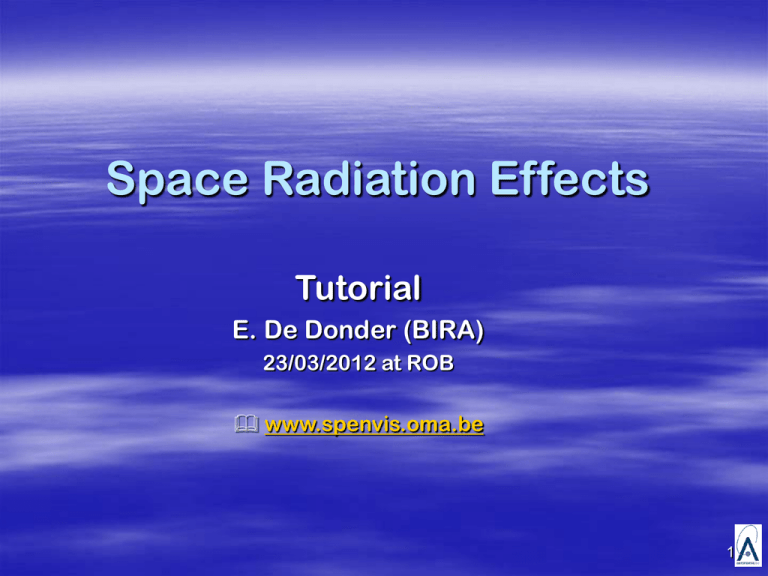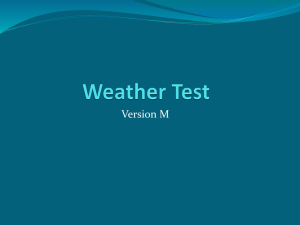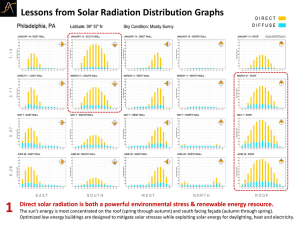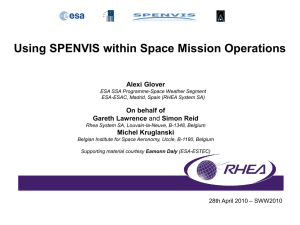Tutorial_Rad_Effetcs_EDD
advertisement

Space Radiation Effects Tutorial E. De Donder (BIRA) 23/03/2012 at ROB www.spenvis.oma.be 1 Outline 1. 2. General overview picture Radiation environment 3. Radiation effects 4. GCR particles Solar particles Trapped particles Secondary particles Total Ionizing Dose (TID) Displacement Damage (DDD) Single Event Effects (SEE) S/c charging Solar storm threat-matrix 2 Radiation environment Plasma environment Neutral environment + drag Microparticle environment 3 Radiation environment (1/4): GCR particles protons and heavy ions (Z>1, mostly fully ionized) E ~ 0.01 – 103 GeV/n modulated by solar cycle, Forbush decrease due to CME anomalous component : 1x ionised He, N, O, Ne, Ar with 10 < E < 100 MeV/n → only during sol.min. GCR H & Fe fluxes at LEO, MEO, GEO and GTO (model: ISO 15390 sol. min.) 1.00E+01 LEO MEO GEO GTO 1.00E+00 1.00E-01 1.00E-02 2 Differential flux (/m /sr/s/(MeV/n)) H Magnetic rigidity = momentum per charge 1.00E-03 Fe 1.00E-04 Energy required to penetrate Earth’s magnetic field (Stassinopoulos et al., 2003) 1.00E-05 1.00E-06 SPENVIS-4.5 1.00E-07 1 10 100 1000 10000 100000 E (MeV/n) 4 Radiation environment (2/4): Solar particles Solar wind: electrons, protons, heavy ions (single ionised) ~0.5 – 2.0 keV/n → acceleration to high energies (up to 500 MeV/n and higher) - during solar flares (impulsive SEP event, heavy ion rich) - by shocks associated to CMEs (gradual SEP event, proton rich) CREME-96 Solar Flare "Worst Day" model (Oct. 1989) 1.0E+10 LEO MEO GEO GTO 1.0E+09 H Differential Flux (/m2/sr/s/(MeV/n)) 1.0E+08 1.0E+07 1.0E+06 1.0E+05 Fe 1.0E+04 1.0E+03 1.0E+02 1.0E+01 1.0E+00 1.0E-01 1.0E-02 1.0E-03 1.0E-04 0.1 SPENVIS -4.5 1 10 100 1000 E (MeV/n) 5 Radiation environment (3/4): Trapped particles Electrons : - 0.04 – 7 MeV - L = ~ 1.5 (inner zone) and 2.8 < L < 12 (outer zone) → highly dynamic - solar wind, ionosphere Protons : - 0.04 – 500 MeV - 1.5 < L < 2.5 - cosmic ray albedo neutron decay SAA: South Atlantic Anomaly / Southeast Asian Anomaly Polar horns SPENVIS – 4.5 E.J. Daly, 1996 6 AP-8 proton fluxes (full lines) and AE-8 electron fluxes (dotted lines) at sol. maximum 1.0E+12 LEO MEO GEO GTO 1.0E+11 1.0E+10 Differential flux (/m2/s/sr/MeV) 1.0E+09 1.0E+08 1.0E+07 1.0E+06 1.0E+05 1.0E+04 1.0E+03 1.0E+02 1.0E+01 1.0E+00 1.0E-01 1.0E-02 1.0E-03 1.0E-04 0.01 SPENVIS -4.5 0.1 1 10 100 1000 E (MeV) 7 Radiation environment (4/4): Secondary particles → interaction with s/c shielding material Secondary particle fluence energy spectra after 20-mm aluminum shield for an incident trapped proton spectrum accumulated over one year. The spectra are from a 10 incident protons simulation. 8 → interaction with atmosphere GCR and SEP flux satellite (GOES/ACE) data, observed during Halloween event 2003) propagated (with NAIRAS model) to top level atmosphere and cruise altitude (10-12 km). (from C. Mertens, 2010) 9 MIT OpenCourseWare 10 Radiation Effects Energy deposition → Dose in rads (M) or Gy: dE/dm Space environment dose rate ~10-4 – 10-2 rad/s → low X fluence Ionisation Dose LET (linear energy transfer) Non-ionisation Dose NIEL (non-ionising energy loss) Long-term effects → degradation of performance Short-term effects → soft and hard errors 11 LET f(E) MZ2 E (Adams et al., 1987) Summers, 1993. 12 Radiation Effects (1/4): Total Ionizing Dose (TID) ▪ cumulative long term ionizing damage due to the production of electron – hole pairs effects: - build up of charges/defects → device degradation (e.g. Vth shift and increasing leakage currents) - DNA damage ▪ main source: > 0.1 MeV protons (trapped & solar), electrons (trapped) 13 Radiation Effects (2/4): Displacement Damage Dose (DDD) ▪ cumulative long term non-ionizing damage due to the production of Frenkel pairs (vacancies and interstitials) effects: lattice defects → parametric degradation (optical devices) like Pout decrease of solar cells ▪ main source: > 150 keV (0.3 – 5 MeV for solar cells) electrons (trapped) > 1 MeV (1 – 10 MeV for solar cells) protons (trapped and solar) neutrons 14 SOHO’s Solar Array Degradation History Solar array degradation: Net loss in two week period 1.1% 15 Radiation Effects (3/4): Single Event Effect (SEE) ▪ stochastic effect caused by the production of small, spurious charge pulses within electronics ▪ processes: - direct ionization by single particle (heavy ion) - induced ionization via nucl. reaction (proton & neutron) ▪ effects: → errors in memory devices like logic change (soft) and burn-out (hard) → lit up of pixels of CCD by creation of free charge → DNA damage main source: > 10 MeV/n protons (trapped & solar), heavy ions (GCR & solar), neutrons charge ~Z2 H. Becker, et al, IEEE Trans. Nucl. Sci., 49(3082), 2002 16 SOHO image: “snowing on 14 July 2000 October 1989 event UoSAT-2 ( polar orbit of altitude about 700km) 17 Radiation Effects (4/4): S/c charging ▪ accumulation of electric charge on s/c surface from natural space plasma → surface charging – ▪ accumulation of electric charge on internal dielectrics from penetrating high-energy electrons → internal dielectric charging – ▪ Main source : 0.01 – 100 keV electrons Main source: > 100 keV electrons (trapped) - “Killer electrons” effects: (breakdown) discharges 18 During substorms, a hot plasma is injected from the magnetotail into the nightside high-altitude equatorial regions. The electrons gradient- curvature drift towards dawn and can dominate the charge balance on a vehicle The hazard arises when adjacent surfaces rise to different enough potentials to drive a discharge A discharge can introduce unintended signals of tens of volts amplitude in command and power lines Surface damage in a C2 MOS Capacitor (Image from JPL) High speed solar wind and killer electrons 19 Summary: Radiation Effects in Space Radiation Effect Impact on Mission Space Environment Natural Variation in Environment surface charging biasing of instrument readings power drain physical damage 0.01 - 100 keV: electrons minutes surface dose changes in thermal, electrical, and optical properties UV, atomic oxygen, particle radiation minutes deep-dielectric charging electrical discharges causing physical damage >100 keV electrons hours total ionizing dose performance degradation loss of function loss of mission >100 keV: trapped protons and electrons, solar protons hours non-ionizing dose degradation of optical components and solar cells > 1 MeV: trapped protons, solar protons, neutrons days single event effects data corruption noise on images interruption of service loss of s/c > 10 MeV/n: trapped protons, solar protons, solar heavy ions, GCR heavy ions, neutrons days 20 http://www.aero.org/publications/crosslink/summer2003/02_table1.html 21 Solar Storm: flare, SPE, CME Enhanced EM Radiation (X, EUV, radio, g) Arrival time: 8 min Effect duration: 1-2 hrs High Energy Charged Particles (p+: 10 MeV – 20 GeV) Arrival time: 15 min – few hours Effect duration: hours - days Enhanced B Field/ Plasma Clouds Arrival time: 2 – 4 days Effect duration: days → e- density in ionosphere → expansion atmosphere → increased radiation exposure → induced currents → geomagnetic field distortion • high-altitude hf radio blackout • high-altitude aircraft radiation • satellite desorientation • s/c electronics damage • s/c solar panel degradation • false sensor readings • launch payload failure • human cell damage • ozon layer depletion • hf radio blackout • shift of outer radiation belt • s/c charging • radar false targets • satcom interference • oil and gas pipeline corrosion • electrical power blackouts • hf radio blackout • satcom inteference • radar interference • image interference • satellite drag 22 Threat matrix Threat Flare SPE CME Induced current power plant outage oil and gas pipelines long distant communication lines Geomagnetic field distortions transient distortion magnetic pulses Radiation exposure humans s/c electronics air and ground based electronics Ionospheric Reflectivity and Scintillations communication radar navigation Other atmospheric effects aurora atmospheric envelope expansion shifting radiation belts ozon layer depletion ‘Solar storm threat analysis’ by J.A. Marusek (http://www.breadandbutterscience.com/SSTA.pdf) 23 References. E.G. Stassinopoulos et al., “A systematical global mapping of the radiation field at aviation altitudes, Space Weather, Vol. 1, No. 1, 1005, 2003. Adams, Jr., et al., “A comprehensive table of ion stopping powers and ranges”, NRL Memorandum Report, 1987. June, I., et al., “Proton Nonionising Enegy Loss (NIEL) for Device applications”, IEEE Transactions on Nuclear Science, Vol. 50, No. 6, Dec. 2003 June, I., et al., “Electron Nonionising Enegy Loss (NIEL) for Device applications”, IEEE Transactions on Nuclear Science, Vol. 56, No. 6, Dec. 2009 C.J. Mertens et al., “Geomagnetic influence on aircraft radiation exposure during a solar energetic particle event in october 2003, Space Weather 8(S03006): doi:10.1029/2009SW000487 (2010a) G. P. Summers, Damage Correlation in Semiconductors Exposed to Gamma, Electron, and Proton Radiations, IEEE Trans. Nuc. Sci. 40, pp. 1300, 1993. 24 25








